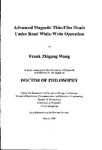Advanced Magnetic Thin-Film Heads Under Read-While-Write Operation
| dc.contributor.author | Wang, Frank Zhigang | |
| dc.contributor.other | School of Engineering, Computing and Mathematics | en_US |
| dc.date.accessioned | 2013-10-24T12:45:41Z | |
| dc.date.available | 2013-10-24T12:45:41Z | |
| dc.date.issued | 1999 | |
| dc.identifier | NOT AVAILABLE | en_US |
| dc.identifier.uri | http://hdl.handle.net/10026.1/2353 | |
| dc.description.abstract |
A Read-While-Write (RWW) operation for tape and/or potentially disk applications is needed in the following three cases: 1. High reliability; 2. Data servo systems; 3. Buried servo systems. All these applications mean that the read (servo) head and write head are operative simultaneously. Consequently, RWW operation will require work to suppress the so-called crossfeed field radiation from the write head. Traditionally, write-read crossfeed has been reduced in conventional magnetic recording heads by a variety of screening methods, but the effectness of these methods is very limited. On the other hand, the early theoretical investigations of the crossfeed problem concentrating on the flux line pattern in front of a head structure based on a simplified model, may not be comprehensive. Today a growing number of magnetic recording equipment manufacturers employ thin-film technology to fabricate heads and thereby the size of the modern head is much smaller than in the past. The increasing use of thin-film metallic magnetic materials for heads, along with the appearance of other new technologies, such as the MR reproductive mode and keepered media, has stimulated the need for an increased understanding of the crossfeed problem by advanced analysis methods and a satisfactory practical solution to achieve the RWW operation. The work described in this thesis to suppress the crossfeed field involves both a novel reproductive mode of a Dual Magnetoresistive (DMR) head, which was originally designed to gain a large reproduce sensitivity at high linear recording densities exceeding 100 kFCI, playing the key role in suppressing the crossfeed (the corresponding signal-noise ratio is over 38 dB), and several other compensation schemes, giving further suppression. Advanced analytical and numerical methods of estimating crossfeed in single and multi track thin-film/MR heads under both DC and AC excitations can often help a head designer understand how the crossfeed field spreads and therefore how to suppress the crossfeed field from the standpoint of an overall head configuration. This work also assesses the scale of the crossfeed problem by making measurements on current and improved heads, thereby adapting the main contributors to crossfeed. The relevance of this work to the computer industry is clear for achieving simultaneous operation of the read head and write head, especially in a thin-film head assembly. This is because computer data rates must increase to meet the demands of storing more and more information in less time as computer graphics packages become more sophisticated. | en_US |
| dc.description.sponsorship | Hewlett Packard | en_US |
| dc.language.iso | en | en_US |
| dc.publisher | University of Plymouth | en_US |
| dc.title | Advanced Magnetic Thin-Film Heads Under Read-While-Write Operation | en_US |
| dc.type | Thesis | |
| dc.identifier.doi | http://dx.doi.org/10.24382/4086 | |
| dc.identifier.doi | http://dx.doi.org/10.24382/4086 |
Files in this item
This item appears in the following Collection(s)
-
01 Research Theses Main Collection
Research Theses Main


